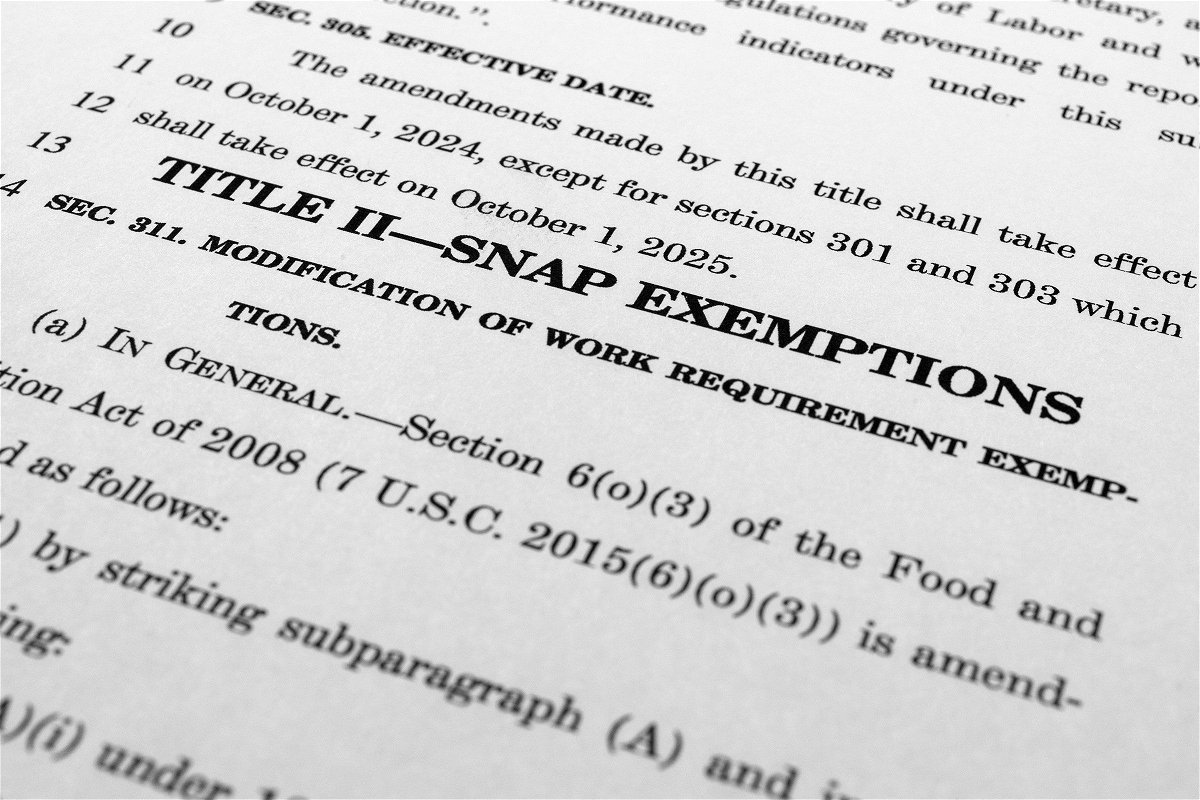Here’s who would have to work for government benefits – and who wouldn’t – under the debt ceiling package

The draft of a bill that President Joe Biden and House Speaker Kevin McCarthy negotiated to raise the nation's debt ceiling is photographed on May 29.
By Tami Luhby, CNN
(CNN) — Work requirements in two safety net programs for low-income Americans are set to change under the compromise debt ceiling package negotiated by President Joe Biden and House Speaker Kevin McCarthy.
Broadening work requirements was one of the main sticking points of the deal, with House Republicans demanding additional mandates, many Democratic lawmakers voicing concerns and Biden opening the door to allowing some modifications of the current rules.
In the end, new measures were included in the legislation, though they are not as stringent as those contained in the debt ceiling bill House Republicans approved in late April.
GOP lawmakers stress that work requirements will help end people’s dependency on the government and lift them out of poverty.
“A job provides financial stability, a rising income, and most importantly, an opportunity to pursue the American dream,” New York Rep. Elise Stefanik, the third highest-ranking Republican in the House, said in a call with reporters this week.
Research, however, shows that work requirements don’t increase labor force participation among safety net recipients, according to Katherine Hempstead, a senior policy adviser with the Robert Wood Johnson Foundation, who recently authored a research brief on the economic and health consequences of work mandates.
What’s more, the additional paperwork discourages participation in government assistance programs and increases the cost of administering the benefits, she found. Plus, the mandates don’t address the barriers to employment faced by many recipients who don’t already work.
Who is affected and how by the debt ceiling package will depend on several factors, including age and state of residence.
Here’s what’s changing in each program:
Supplemental Nutrition Assistance Program
Current: Able-bodied adults without dependents who are between ages 18 and 49 can only receive food stamps for three months out of every three years unless they work or participate in other activities at least 20 hours a week.
New: The number of people subject to the mandate will be broadened in phases so that by 2025, it will apply to those between the ages of 18 and 54.
But veterans and people experiencing homelessness of all ages, as well as adults under age 25 who were previously in foster care, will be exempt under the debt ceiling bill.
These provisions will expire in October 2030.
The legislation also tightens the share of unused exemptions states can carry over from year to year.
Nearly 750,000 adults ages 50 through 54 could be newly subject to the expanded work requirement and at risk of losing their nutrition assistance under this work requirement, according to an analysis by the Center on Budget and Policy Priorities. Nearly half of those newly at risk are women. Many of these recipients have very low incomes and have health conditions that could limit their ability to work.
About 250,000 folks between the ages of 50 and 54 would likely lose benefits – equaling about $8 a day per person – under the new rules, according to the center’s analysis of Congressional Budget Office data.
The CBO estimates that overall, because of the new exemptions, some 78,000 more people would be enrolled in the Supplemental Nutrition Assistance Program, or SNAP, as food stamps are formally known.
But states may have difficulty tracking their beneficiaries to determine whether they qualify for exemptions, the center noted.
Lots of people who are in compliance with the new rules – either because they already work or meet exemption criteria – could lose their assistance because of red tape, said Dottie Rosenbaum, the center’s director of federal SNAP policy.
The earlier House GOP debt limit bill would have also required 55-year-olds to work to receive benefits.
Temporary Assistance for Needy Families
Current: States must ensure that a certain share of those receiving cash aid from the Temporary Assistance for Needy Families program participate in specific work-related activities – 50% for all families and 90% for two-parent households.
Only certain activities, including employment, training, job search assistance and community service programs, satisfy the mandate.
About 540,000 families who received cash assistance from TANF were subject to the work requirements in 2021, according to LaDonna Pavetti, a senior fellow at the center. The families included about 975,000 children.
States can lower their required workforce participation rate by reducing the number of families receiving cash payments. Many states have been able to take advantage of this provision.
New: The legislation tightens the current work requirements, primarily by adjusting the work participation rate credits that states can receive for reducing their number of cases. Starting in October 2025, the formula will compare the current count with what it was in 2015, instead of 2005.
Because caseloads declined significantly in most states between 2005 and 2015, these states will have to make sure a greater share of families are working to meet the mandate, Pavetti said.
It would also bar states from counting people who receive less than $35 in monthly assistance from TANF in their work participation rate, which Republicans say states send to those already employed to help them meet the requirement.
But the package also includes two useful provisions, Pavetti said. It will require states to follow recipients of cash assistance after they leave TANF and report on the shares who have earnings and who are employed. Also, it will set up a pilot program that will judge up to five states on the earnings and employment of recipients after they exit TANF rather than on the work participation rates of those still in the program.
How these changes will affect those who receive TANF cash assistance will depend greatly on the state they live in, how their state’s caseloads compare with 2015 and how states address any shortfall in their work participation rates, Pavetti said.
For instance, some states could opt to give all their cash assistance funds to children living with guardians or other people who aren’t their parents since these adults are not counted in the work participation rate.
Other states may require parents to be working in order to qualify for cash assistance in the first place.
But low-income Americans will feel an impact.
“The families most likely to lose benefits are the ones with the greatest needs,” Pavetti said, citing those who can’t work because of illness, lack of housing or other barriers.
The earlier House GOP bill would have required the formula for the credits to compare the current count with what it was in 2022, which would have effectively zeroed out the credit in every state, Pavetti said.
Medicaid
Current: No federal work requirement.
The Trump administration granted waivers to several states to impose such a mandate on certain enrollees. Litigation stopped or chilled states’ implementation of the effort, and the Biden administration subsequently withdrew the permissions – though a federal district court judge allowed the initiative to proceed in Georgia.
New: No federal work requirement.
House Republicans had wanted to require certain adult Medicaid recipients to work, perform community service or participate in an employment program for at least 80 hours a month or earn a certain minimum monthly income. Their earlier bill called for applying this mandate to those ages 19 to 55, but not those who are pregnant, parents of dependent children, physically or mentally unfit for employment or enrolled in education or in substance abuse programs, among others.
The provision would have resulted in about 1.5 million adults, on average, losing federal funding for their Medicaid coverage, according to the CBO. But states would have picked up the full tab for about 900,000 of them, leaving around 600,000 uninsured.
The-CNN-Wire
™ & © 2023 Cable News Network, Inc., a Warner Bros. Discovery Company. All rights reserved.


